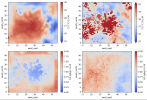Hi all,
I ran WRF-Noah-LSM and WRF-CTSM at 1.2 km spatial resolution.
The plot (a) show higher skin temperature in the west and south than in the city center. Is it normal? How to explain it?
I also found such patterns in https://doi.org/10.1002/2018JD028377.
Thanks for any comments.
Best,
Yuan

I ran WRF-Noah-LSM and WRF-CTSM at 1.2 km spatial resolution.
The plot (a) show higher skin temperature in the west and south than in the city center. Is it normal? How to explain it?
I also found such patterns in https://doi.org/10.1002/2018JD028377.
Thanks for any comments.
Best,
Yuan




